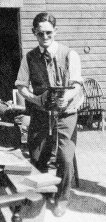
| Howard Frizelle 'Billy' Burton was one of
those pilots who seemed intended for much greater things, but thanks to the random nature
of war has become known to relatively few people. 'Billy' had a very promising start, winning the Cranwell Sword of Honour when he passed out in December 1936. From there he served with 46 Sqn flying Gloster Gauntlets, transferring to 12 Group HQ in June 1939 on staff duties. When war started he transferred again to 66 Sqn as 'B' Flight commander. It is during this period that he is referred to in Wing Commander Dizzy Allen's book Fighter Squadron. "He was quite short, tough, erect, a gentleman, a product of a public school and the RAF Officers' Cadet School at Cranwell. I suppose he was aged twenty-five, beating me in years by five and in flying experience by a factor of five or more". On 3rd September 1940 he moved again, taking over command of 616 Sqn from Marcus Robinson. The following months were hectic, but must have also been frustrating. Because Bader flew so often with 616 'Billy' did not have the same degree of autonomy available to the other squadron commanders in the Tangmere Wing. Shortly after Bader's loss he got his DFC, and on 1st October was posted again, this time to 11 Group HQ as Squadron Leader Tactics. Burton's next move was to the North African front flying tank-busting Kittyhawks. During this period he earned his DSO. Following this tour he returned to Britain for a short while. His return flight to North Africa met with disaster. The aircraft in which he and several other high ranking officers was flying was intercepted over the Bay of Biscay when the pilot chose to fly in daylight. It was shot down with no survivors. Much of the detailed information above was found in Dilip Sarkar's excellent book Bader's Tangmere Spitfires.
|
© Copyright Ian Wedge, 1999
Last updated 18 February 2002